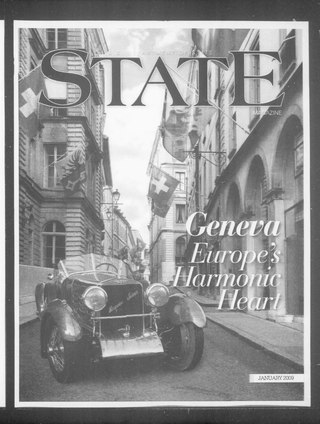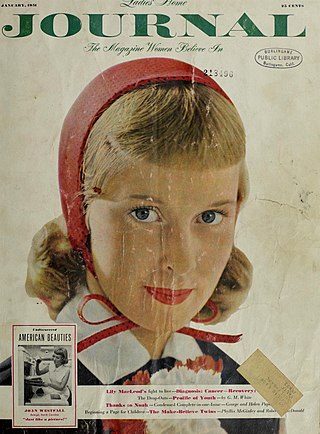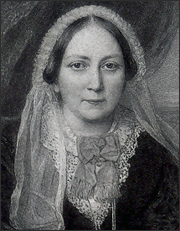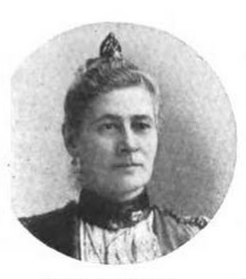
A magazine is a periodical publication, generally published on a regular schedule, containing a variety of content. They are generally financed by advertising, purchase price, prepaid subscriptions, or by a combination of the three.

Godey's Lady's Book, alternatively known as Godey's Magazine and Lady's Book, was an American women's magazine that was published in Philadelphia from 1830 to 1898. It was the most widely circulated magazine in the period before the Civil War. Its circulation rose from 70,000 in the 1840s to 150,000 in 1860. In the 1860s Godey's considered itself the "queen of monthlies". After several changes, it ceased publication in 1896.

Ladies' Home Journal was an American magazine that ran until 2016 and was last published by the Meredith Corporation. It was first published on February 16, 1883, and eventually became one of the leading women's magazines of the 20th century in the United States. In 1891, it was published in Philadelphia by the Curtis Publishing Company. In 1903, it was the first American magazine to reach one million subscribers.

Lycoming Engines is a major American manufacturer of aircraft engines. With a factory in Williamsport, Pennsylvania, Lycoming produces a line of horizontally opposed, air-cooled, four, six and eight-cylinder engines including the only FAA-certified aerobatic and helicopter piston engines on the market.

1860s fashion in European and European-influenced countries is characterized by extremely full-skirted women's fashions relying on crinolines and hoops and the emergence of "alternative fashions" under the influence of the Artistic Dress movement.

Ellen Price was an English novelist better known as Mrs. Henry Wood. She is best remembered for her 1861 novel East Lynne. Many of her books sold well internationally and were widely read in the United States. In her time, she surpassed Charles Dickens in fame in Australia.

John Cassell was an English publisher, printer, writer and editor, who founded the firm Cassell & Co, famous for its educational books and periodicals, and which pioneered the serial publication of novels. He was also a well-known tea and coffee merchant and a general business entrepreneur who supposedly sold and coined the term Cazeline which mutated into the word gasoline, though dictionaries do not support this etymology. A fervent Christian, he campaigned throughout his life for the temperance movement in Britain, and for the reduction of taxes on publishing. He was a social reformer who recognised the importance of education in improving the life of the working class, and whose many publications, both magazines and books, brought learning and culture to the masses.

Ebenezer Butterick was an American tailor, inventor, manufacturer, and fashion business executive, born in Sterling, Massachusetts.

Jane Cunningham Croly was a British-born American author and journalist, better known by her pseudonym, Jennie June. She was a pioneer author and editor of women's columns in leading newspapers and magazines in New York. She founded the Sorosis club for women in New York in 1868 and in 1889 expanded it nationwide to the General Federation of Women's Clubs. She also founded the Woman's Press Club of New York City.

William Jennings Demorest (1822–1895) was an American magazine publisher, prohibition leader, and businessman from New York City. In collaboration with his second wife, Ellen Demorest, née Curtis, he attained international success from his wife's development of paper patterns printed in Demorest's Illustrated Monthly. Together, they built a fashion manufacturing and merchandising empire from it.

Ellen Louise Demorest was an American businesswoman, fashion arbiter and milliner, widely credited for inventing mass-produced tissue-paper dressmaking patterns. With her husband, William Jennings Demorest, she established a company to sell the patterns, which were adaptations of the latest French fashions, and a magazine to promote them in 1860. Her dressmaking patterns made French styles accessible to ordinary women, thus greatly influencing US fashion.
The Butterick Publishing Company was founded by Ebenezer Butterick to distribute the first graded sewing patterns. By 1867, it had released its first magazine, Ladies Quarterly of Broadway Fashions, followed by The Metropolitan in 1868. These magazines contained patterns and fashion news.
A sewing pattern is the template from which the parts of a garment are traced onto woven or knitted fabrics before being cut out and assembled. Patterns are usually made of paper, and are sometimes made of sturdier materials like paperboard or cardboard if they need to be more robust to withstand repeated use. Before the mid-19th century, many women sewed their own clothing by hand. Factory-produced fabrics were affordable and available in the early 19th century, but easy-to-use dress patterns and sewing machines for the home seamstress were not sold in the United States until the 1850s.

Ada Sarah Ballin was an English author, journalist, editor, and lecturer. She was the editor and proprietor of the magazines Baby, Womanhood and Playtime, and published articles and books on health, child care, and dress reform.

Harriet Newell Austin was an American hydrotherapist, author, and dress-reform advocate. She was the designer of the "American costume," a style of dress meant to promote women's health.
Johanna Wilhelmine Weigel, née Astmann, known professionally as Madame Weigel, was a designer and publisher of dressmaking patterns in Australia.

Jane Marsh Parker was an American author and historian of the long nineteenth century. She was a frequent contributor to The Churchman and other publications of the Protestant Episcopal church. She was the author of novels and religious works, including Toiling and Hoping ; The Boy Missionary (1859); Losing the Way (1860); Under His Banner (1862); The Morgan Boys (1859); Rochester, a Story Historical ; The Midnight Cry ; Life of S. F. B. Morse (1887); and Papers Relating to the Genesee Country (1888), among other publications. A pioneer clubwoman, Parker founded the Fortnightly Ignorance Club of Rochester, New York, which was the first women's club in the state after Sorosis.
















